 |
|
At The Picture Show
|
November 2007
Virtual reality gone wrong
Ambitious and trendy as it may be, motion-capture ruins 'Beowulf's' epic tale
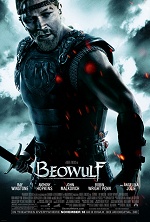
Beowulf
Paramount Pictures
Director: Robert Zemeckis
Screenplay: Neil Gaiman and Roger Avary, based on the epic poem
Starring: Ray Winstone, Anthony Hopkins, Brendan Gleeson, Robin Wright
Penn, Crispin Glover, John Malkovich, Alison Lohman and Angelina Jolie
Rated PG-13 / 1 hour, 53 minutes
Opened November 16, 2007

 (out of four)
(out of four)
Motion-capture is for giant monkeys and fictional creatures. Not for humans. You
see, the thing about giant monkeys and fictional creatures is, they don't really
exist. So when you have a professional actor creating movement, expression,
emotion and violence for, say, King Kong or Gollum, it can be magic.
The thing about humans is, real humans are invariably better than fake ones.
Robert Zemeckis has not yet learned this. After subjecting us to the nightmare-inducing horror of the dead-eyed animatronic zombie freaks in The Polar Express,
he has returned to motion-capture to adapt the legendary epic poem Beowulf in
similar form. The good news? Unlike his last effort, Beowulf actually has a story
and digital Aerosmith does not make an appearance. The bad news? Motion-capture is still an embarrassment.
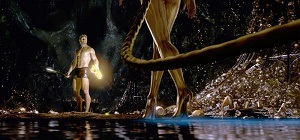 I don't question Zemeckis' talent - only his
motivation for insisting on using this technique. I understand it's new, it's
different, it's advanced, and people want to play around with it. And creating an
entire movie with motion-capture and computer animation adds a whole new level
to directorial control. Theoretically, he can do anything he wants.
I don't question Zemeckis' talent - only his
motivation for insisting on using this technique. I understand it's new, it's
different, it's advanced, and people want to play around with it. And creating an
entire movie with motion-capture and computer animation adds a whole new level
to directorial control. Theoretically, he can do anything he wants.
Except, of course, get beyond the extreme limitations this new freedom
subsequently provides. The facts are these: Human characters created through
motion-capture cannot express emotion, they do not move like humans, their eyes
do not look like they're actually looking at anything; in short, they do not have any
of the nuances that make humans human. Instead, they look like cheap wax statues
that happen to walk and talk - perhaps operated by remote control or something.
Since real and well-known actors are being used, Beowulf is made even more
distracting. Instead of seeing Anthony Hopkins, Angelina Jolie and Co., we get
crappy digital versions of Anthony Hopkins, Angelina Jolie and Co. The
technology is stuck in a sort of middle ground, where it's trying so hard to
replicate reality that it only ends up drawing attention to how fake it looks. Disney
and Warner Bros. cartoons from the 1940s are more emotionally expressive, and
I'm not exaggerating.
This is progress?
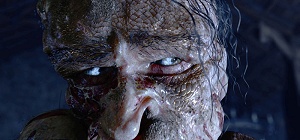 The real frustration is how unnecessary it is in the
first place. Recent movies like Sin City, Sky Captain and the World of Tomorrow
and 300 have used similar filmmaking techniques - green screen, sets and
backgrounds created by digital artists, stylized animated environments - and have
blended real actors in perfectly with their surroundings. The characters, the
costumes, the sets, the CGI - it's all been in sync. If those movies can do it with
real actors - actors who can actually express something - why can't Beowulf?
The real frustration is how unnecessary it is in the
first place. Recent movies like Sin City, Sky Captain and the World of Tomorrow
and 300 have used similar filmmaking techniques - green screen, sets and
backgrounds created by digital artists, stylized animated environments - and have
blended real actors in perfectly with their surroundings. The characters, the
costumes, the sets, the CGI - it's all been in sync. If those movies can do it with
real actors - actors who can actually express something - why can't Beowulf?
I know - that's not what Zemeckis wanted to do. Fine. But his way doesn't work.
His characters look like junk. It's most obvious during the scenes that are
supposed to be emotionally dramatic. We know what we're supposed to feel, but
we're getting absolutely nothing from the characters. Instead, it feels like we're
watching a scene from a video game.
The one major exception in Beowulf - tellingly - is Grendel, the sound-sensitive
monster who wreaks vengeance on Hrothgar's (Hopkins) kingdom. Like everyone
else, Grendel was created using motion-capture with Crispin Glover. Since he
doesn't have the handicap of being a human character, he comes across naturally
and wonderfully. We notice the great visual design of the creature, and his big
entrance - as he tears apart the mess hall - might be the best scene in the film.
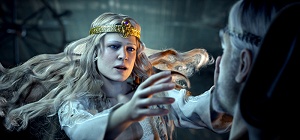 Beowulf (Ray Winstone) is the boastful warrior
who comes to Hrothgar's mead hall, Heorot, to kill the beast, and winds up under
the spell of Grendel's mother, played by Jolie. (Who I believe has now done the
exact same accent in three movies, Alexander, A Mighty Heart and now Beowulf. I
think it's called "Foreign Person Accent, Regardless of Country of Origin.")
Beowulf (Ray Winstone) is the boastful warrior
who comes to Hrothgar's mead hall, Heorot, to kill the beast, and winds up under
the spell of Grendel's mother, played by Jolie. (Who I believe has now done the
exact same accent in three movies, Alexander, A Mighty Heart and now Beowulf. I
think it's called "Foreign Person Accent, Regardless of Country of Origin.")
Even if the script is somewhat undercooked, there's enough of a story there to get
over the narrative limitations. Zemeckis and cinematographer Robert Presley
definitely have a sense of the world they've created - the fluid camerawork helps
introduce us to a digital world that is actually quite nicely designed.
But even during the action sequences, Zemeckis gets in his own way. When
Beowulf fights Grendel, he's completely naked the entire time. But instead of
allowing for a possible R rating or changing the scene by slapping a loincloth on
the guy, the filmmakers decide to find a bunch of ways to not-so-subtly hide,
shadow or cover up his manhood. It's so obvious and laughable, and draws so
much attention to itself, that it takes away from the scene. (On a side note, there
was a brilliant naked fight scene in this year's Eastern Promises, which never tried
to hide anything to appease a ratings board, and it's one of the most gripping
action scenes I've seen in a long time. But I digress...)
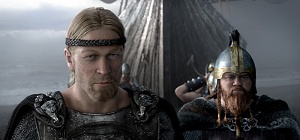 I admire that someone like Zemeckis is trying to
push the technological envelope, but as of right now, it's only working against
him. His 1988 masterpiece Who Framed Roger Rabbit was ahead of its time and
has aged as well as just about anything from the '80s. Neither Beowulf nor The
Polar Express will do the same.
I admire that someone like Zemeckis is trying to
push the technological envelope, but as of right now, it's only working against
him. His 1988 masterpiece Who Framed Roger Rabbit was ahead of its time and
has aged as well as just about anything from the '80s. Neither Beowulf nor The
Polar Express will do the same.
Read more by Chris Bellamy